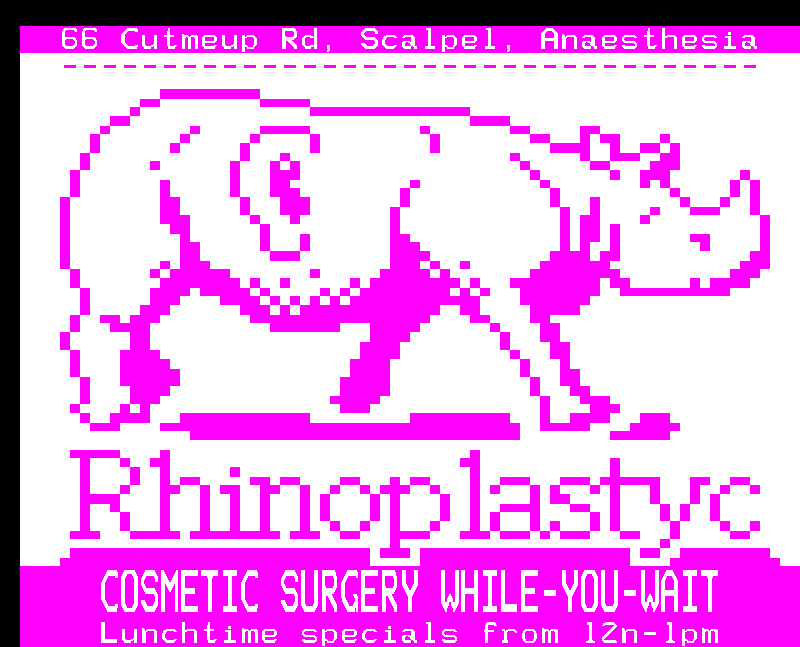Once you had an entire generation of software developers who had grown up cutting their teeth on BBSes (and, one assumes, occasionally partaking in a dram of warez), then you had people who appreciated the nostalgic power of the iconography of textmode art (and its earliest historic context -- as sparks of green or amber light against a black background) now working in the software industry and incorporating it into their own productions. One of the highest-profile appearances must have been the (computer-generated) images appearing in conjunction with "Still Alive" during the final credits roll from Valve's Portal (and a not entirely unrelated note here, the "ASCII Portal" adaptation):
The '80s BBS context is invoked explicitly by Jim Munroe in his 2012 game "Guilded Youth", which takes place in two settings -- one, real-world suburbs, and two, a fantasy-themed multi-node dialup BBS accessible via C64. I don't know if artist Matt Hammill had authentic background experience in the computer art underground, but if not -- he sure did a good job faking it! (I know, this is ASCII-ish, and the C64 would have had PETSCII graphics, but I'm willing to overlook the historical inaccuracy.) And here the pictures are in context, complete with a login activity transcript: (And for contrast, the underwhelming offline "real world":) 2010's Digital: A Love Story is a fascinating case study, set "5 minutes into the future of 1988" by its creator Christine Love -- who is young enough that she never got a chance to experience the BBS scene firsthand, reconstructing the milieu and aesthetic through research at the self-same textfiles.com whose Public Domain ANSI art vaults I've been recently plundering myself. What she arrived at wasn't quite ANSI art, but it was darned close! You begin in the Public Domain... (This one is basically an outtake from Noel Gamboa's Star Trek ANSI collection!) Gradually players expand their phone list and possible locations in cyberspace they can call into. (This is a nice thought, but no academic institution would ever have featured friendly ANSI art on their welcome screen -- online access in the late '80s was a spartan, user-unfriendly world accessible only to gurus at ease at a Unix shell prompt.) Finally we begin ekeing our way into the realms of the true elites... (a little spacing on that font, please!) (Hilariously playing against type, the underground warez board features the most stock, TheDraw-ish ANSI art in the entire game! This is ironic, presumably unwittingly, as it was the digital underground who elevated ANSI art beyond its crudest initial applications to something that anyone might want to look at. But as we have seen, 1988 predates the underground artscene -- ACiD only got going in 1992 -- so this is all looking a bit ahead of its setting.) She may never have called a BBS, but I gather she read Neuromancer! Imagine those patterns as a species of Matrix code revealing itself... And then we have Sam Barlow's 2015 FMV game Her Story. Most of this game is spent poring over interview footage, but knowing of my interest, a friend sent over these photos of some exceptional content:What's the context for these images?That logo is plainly machine-generated, as is the accompanying illustration, but to be fair, the game constrains these pieces to tiny windows, a much smaller canvas than the traditional 80x25 MS-DOS screen would allow... I doubt that a human would be able to accomplish much more with these limitations. You got me -- it is a touch of class! Not a faithful reproduction of warez packaging, but a passable echo from memories of it. There was another game I wanted to talk up in this post, Sisters of the Amniotic Lens, featuring a quantity of teletext from Illarterite ... but I must confess, the deliberately user-hostile interface interfered with my attempts to get far enough into the game to capture some of its in-game teletext appearances to show you. Fortunately, he has provided a gallery, so I can just poach from there: And finally, the big attraction: Bethesda's 2015 release Fallout 4 included a cute nod to the artscene's parallel H/P/A (hack / phreak / anarchy) scene, with unlockable hacking powers enabled after finding illustrated dot matrix printouts of tfiles (text files) filled with esoteric electronics lore, issues of the "Total Hack" 'zine, naturally given ASCII art cover illustrations. You can hack spotlights... you can hack turrets... ... and even robots! It's just a pity there weren't more issues! That wraps it up for this long-waiting-in-the-queue post, but of course this just scrapes the tip of the iceberg of games using textmode art. These were just the ones that employed it in some valid context in which textmode art could be reasonably expected -- of course, a whole generation of software designers made games in textmode (often cunningly employing remapped character sets, as with Teoman Irmak's work on Adventuresoft's illustrated text adventures) because that's all they had... or at least, that's all they could figure out how to use... and then there are roguelikes... but that's grist for a whole other post, to be sure!The player is looking around on a police computer and in the Recycle Bin there is a game and its nfofile"

















